In the article the estimation of scientific researches and ecological monitoring soils that were executed in China is given, to study quality of soil and provide the scientific founding for creation of ecological politics. And similarly in the article given results of past and current quality reviews of soil and supervisory actions in China. And also in the article led supposition of fears concerning the second-rate concentrations of elements in soil, and ecological standards of soil and recommendation in China. Levels of contamination are in municipal soil, in mining industry used agricultural soil and soil indexes of contamination and concentration. On the ecological standard of quality of soils two organic pollutants and a few heavy metals (cadmium, Mercury, arsenic, copper, lead, chrome, zinc and nickel) are educed.
Over the past few decades, numerous concerns have been raised in China over the issue of environmental sustainability. Various soil survey and monitoring programs have been carried out in China to study soil quality, and to provide a scientific basis for environment policy making. This paper provides an overview of past and current soil quality surveys and monitoring activities in China. This paper includes a summary of concerns over background concentrations of elements in soil, and soil environmental standards and guidelines in China. Levels of pollution in urban soil, agricultural soil, and soil in mining and smelting areas were compared using the concentrations and pollution indexes. In addition to soil surveys, soil monitoring is essential to study the data and to examine the effects of contaminants in soils. However, the current soil quality monitoring system was insufficient to accurately determine the soil quality status of soils across China. For accurate soil monitoring in China, it will be necessary to set up routine monitoring systems at various scales (national, provincial, and local scales), taking into consideration monitoring indicators and quality assurance. This is currently an important priority for the environmental protection administration of China.
China’s polluted land is in urgent need of cleaning up, but at present there is a lack of both experience and legislation, says Gao Shengda
In China there is no single standard for remediation of industrial and mining sites, or for urban land.
Much polluted farmland goes untreated.
In late 2013, the Ministry of Land and Resources revealed that approximately 50 million mu (3.3 million hectares) of farmland was «moderately» polluted. In response, in late March, the Ministry of Environmental Protection (MEP) proposed its «Action Plan for Prevention of Soil Pollution».
Soil pollution comes mainly from mining and industrial activity. China’s 30 years of rapid economic growth have inevitably caused many environmental problems. Europe and the US saw the same thing during their periods of quick growth.
Polluted farmland is more serious in provinces with mining areas: Hunan, Guangxi, Jiangxi, Guizhou, Gansu. In urban areas pollution is mainly due to heavy metal and petrochemical production. But that pollution isn’t just due to output for China’s own needs. In recent years many overseas manufacturers have moved to China and become major sources of pollution.
The increased frequency of incidents is down to three reasons: first, soil and groundwater pollution is hidden, and previously it wasn’t a matter of concern. Environmental concerns start with what can be seen or felt: surface water pollution, air pollution. Only later does soil or groundwater pollution come to light. That’s been the experience in any country. Over the last two decades China has mainly been concerned with pollution of surface water and the air.
Second, soil and groundwater have a certain environmental capacity — problems don’t become apparent until a certain degree of pollution has accumulated.
Third, in urban areas soil pollution only came to light as industry moved out to make way for the service sector. In 2007, many urban industrial or mining concerns were relocated or shut down to make way for property development, but this exposed urban pollution. For example, in 2004, workers on Beijing’s Line 10 subway fell ill while working a site previously occupied by a pesticide plant. That made the public and the environmental authorities aware of the issue. Then there were similar cases with the Beijing 3rd Chemical Plant, Beijing Hongshi Paint Factory, Beijing Dye Factory, Beijing Coking Plant and Shougang Steel.
But in urban areas there are no confirmed cases of soil pollution causing public health issues. The problem hasn’t been known for very long — it’s only in the last 10 years that this process has started, and identifying a causal relationship requires a long period of observation. That is unless there is a case of very concentrated pollution, such as the Love Canal case in New York, where homes were built on an industrial waste site, leading to a cluster of cancer cases over the following decades.
There is a Soil Environmental Quality Standard for farmland, but this only covers two organic pollutants, Hexachlorocyclohexane and DDT, and eight heavy metals — cadmium, mercury, arsenic, copper, lead, chromium, zinc and nickel — and dates back to 1995. That’s currently being revised to include new pollution standards. It will set standards for levels of different pollutants in different types of land, and if that level is breached the land will be classed as polluted. So that single standard will apply in all cases.
Soil pollution in China is quite serious, but there’s no remediation system and much polluted farmland goes untreated.
There is no single standard for remediation of industrial and mining sites, or for urban land. Currently remediation of urban land is usually done to allow further development. The only standard was set in Shanghai, for the World Expo in 2010, whose site was formerly industrial land. Some provinces have used that as a point of reference for soil remediation efforts.
Other places, such as Beijing, have opted to look to international risk models. This means first assessing risk factors and determining, based on the state of the pollution and the future use of the site, an acceptable risk index: for example, one case of cancer per million people might be deemed acceptable. You then work backwards, to see what level pollution must be reduced to. The lower the acceptable level of risk, the higher the standards for remediation.
Under this model, the purpose of the site determines what level of pollutants will be classed as «polluted».
For example, lower levels of pollutants might be required for a hospital or kindergarten, than for a factory.
Currently this approach is common worldwide — for example in Taiwan, Korea and Japan here in Asia. And that would be the best way for China to get started. People are now aware of the risks of polluted sites, and now we should evaluate those risks. This is a flexible approach: the model may allow for some sites to be subject to less remediation, or to be left untreated. So it works both ways.
At the end of February, the MEP published guidance on the survey, evaluation, remediation and monitoring of polluted sites, providing a standard procedure for dealing with pollution. This boosted market confidence and provided a good norm to follow.
Soil is unlike air or water. If you take an air sample, you can be confident that the air one kilometre away is more or less the same. But soil can change hugely within just a metre. So neither the public nor companies can approach soil pollution in the same way they think about air or water pollution.
And each site is different. One chemical plant might have been operating for longer than another, but if its environmental standards are stricter then its site may be less polluted. In the north groundwater is very deep, in the south nearer the surface, and that changes how pollution migrates. There are differences in types of soil — sandy soil and clay need to be handled differently. There are also differences in the types of pollutants, and the abilities of the companies doing the work.
It takes experience for a doctor to be able to write a prescription and tell you what medicine to take, how much, how often. Soil remediation companies also need to gather experience in assessing and treating soil, and in China these companies are only just getting started. It will take time for them to build up the technology, the personnel, the experience and the background. That’s a limiting factor.
At the industry level, we need better technological skills. In the last ten years soil remediation work has mostly been carried out to allow for property development — usually soil is dug up and taken away for treatment elsewhere. That has prevented the sector developing a diverse range of approaches. Overseas it is more common for pollution to be dealt with in situ. That’s cheaper, but takes longer — from one or two years, to 10 or 20.
Currently there are no laws or regulations on soil pollution, just a document from the Office of the State Council on short-term arrangements for protection and remediation of the soil, and there was also a circular from the MEP. There’s a real need for that action plan, just like there was for the air pollution action plan last year.
But the action plan is still focused on farmland, as the state is mostly concerned with food security. And it’s a five-year plan; it won’t help put long-term systems in place. So there needs to be more powerful legislation, such as the Soil Pollution Law that there’s been so much debate about. The revision of the Environmental Protection Law will include soil pollution, but this is an overall law, it won’t be very specific. A specific law for soil pollution would be able to provide more actual detail.
And China is huge, with big differences in soil, hydrology and geology. China could categorise pollution differently across regions, to allow for a differentiated approach.
Also, China needs better monitoring of soil pollution, and to take action at any time. For example, with filling stations: you can’t wait until there’s a leak, or until the station is closed, to investigate. If fuel leaks it will pollute groundwater, and it’s cheaper to deal with that as soon as possible. If you wait a decade the pollution has spread. That means it does more harm, and is much more costly to clean up.
Soil is the building block of basic materials that constitute the Earth’s environment and it also provides a basis for the survival and development of living organisms, both plants and animals, including human beings. Heavy metals in soil can affect plant growth and have negative impacts on environmental conditions by contributing to air and water pollution. Soil can also be a source of heavy metals migration into animal and human food chains. An assessment of soil safety is to draw the boundary line for polluted soil through predetermined methods or via other means to determine the extent of pollution. Determination of heavy metal pollution in soil can help in the assessment of risks of heavy metals.
Mt. Gongga at its highest peak of 7,556 m above mean sea level (a.s.l.), is situated at 29°20′-30°20′N and 101°30′-102°′E on the eastern edge of the Qinghai-Tibet Plateau, which is in the mid-section of snowbound mountains of Hengduan (Daxue Shan mountain range). This mountain is approximately 60 km wide along the north-south direction and 30 km along the east-west direction. Mt. Gongga is located in the administrative counties of Kangding, Luding, Shimian and Jiulong of Sichuan Province in China. This mountain is characterized by glacier and forest growing region in the Asian maritime monsoon climate zone and is renowned for integrity of its natural geographical band. Dry and hot river valleys, agricultural fields, broadleaved forest, coniferous forest, highland shrubs, alpine meadows and permafrost desert encompass the landscape of the region (Chen and Gao, 1993) [1]. Since the Quaternary Age, its geological tectonics has experienced violent activities. Mt. Gongga region was authorized by the State Council in 1997 to a status of the state-level nature protection area in China. Hailuogou (Conch Valley) is a branch gully along the easternslope of Mt. Gongga. Due to differences in hydrothermal conditions and vegetations, a structurally complex perpendicular band of soils have been formed, which changes with the elevation. From the foot to the peak of the mountain, these complex soils consist of yellow-brown earths below 1,700 m, brown earths at 1,700–2,500 m, dark-brown earths at 2,500–2,900 m, brown coniferous forest soils at 2,900–3,600 m, dark felty soils at 3,600–4,200 m, felty soils at 4,200–4,600 m and frigid frozen soils at 4,600–4,700 m.
The aim of this study was to examine the status of heavy metal contamination (As, Cd, Cr, Hg, Ni and Pb) and assess environmental quality of soil of the major vegetation types along the eastern slope of Mt. Gongga in Sichuan Province (Eastern Tibet) of China. This was to provide scientific basis for sustainable tourism development, protection of ecological environment and reasonable utilization and management of soil resources. The degree of soil pollution with heavy metals was assessed by comparing with the quality assessment approach of soils using a single-factor and multiple-factor heavy metal indices method according to the «Quality Standard of Soil Environment» criterion of China.
Materials and methods
Collection and treatment of soil cores: Soil cores were collected at three observation sites of Gongga Alpine Ecosystem Observation and Experiment Station in Hailuogou along the eastern slope of Mt. Gongga (Fig. 1). The sampling site no. 1 is located in the middle and bottom part of the steep slope (30–35°) of the Faber's Fir (Abies fabri) mature forest. This area is an ‘observation site’ at elevation of 3,100 m and the slope direction is southeast. The site no. 2 is located in the gentle-sloping (5–8°) valley of a ‘Supporting observation site’ in the Faber's Fir/Purdom Poplar (Populus purdomii) succession forest at elevation of 2,950 m and the slope direction is to the east. The site no. 3 is located at the gentle-sloping (7–10°) debris flow fan of the middle-aged Faber's Fir forest at elevation of 3,000 m and the slope direction is southeast.
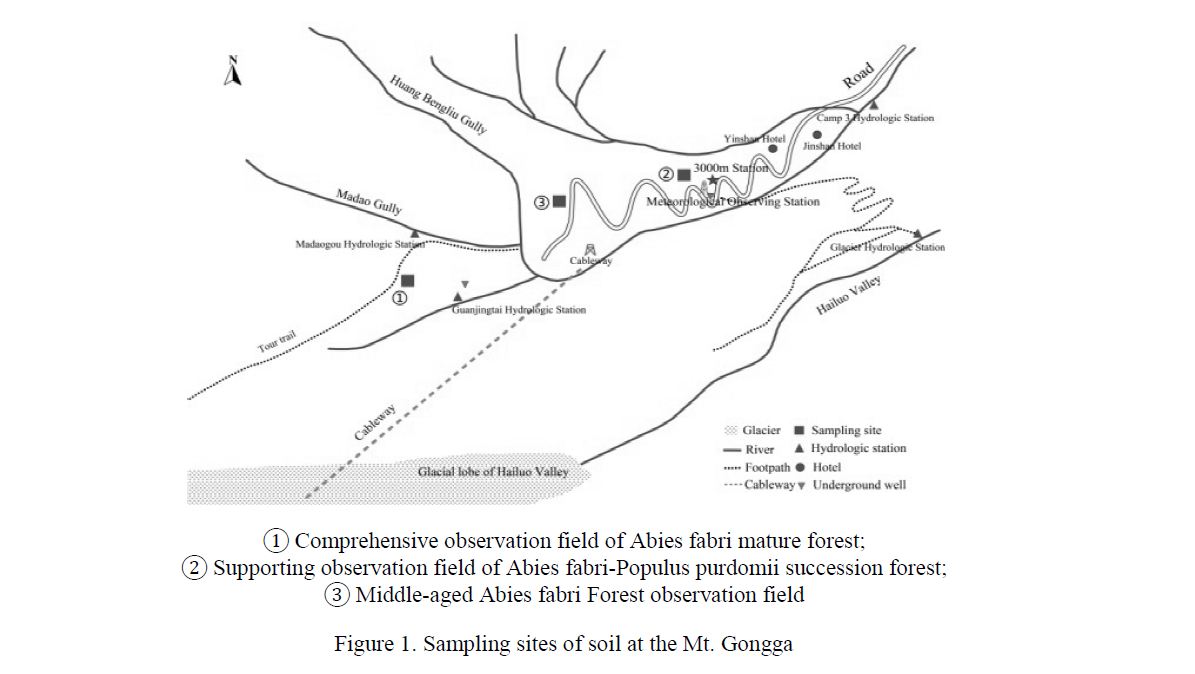
Figure 1. Sampling sites of soil at the Mt. Gongga
At each of these three locations, three sampling points were selected depending on the topography at high, medium and low positions (Ou et al., 2007) of the slope (Table 1) [2].
Characterization of the sampling area and soil
T a b l e 1
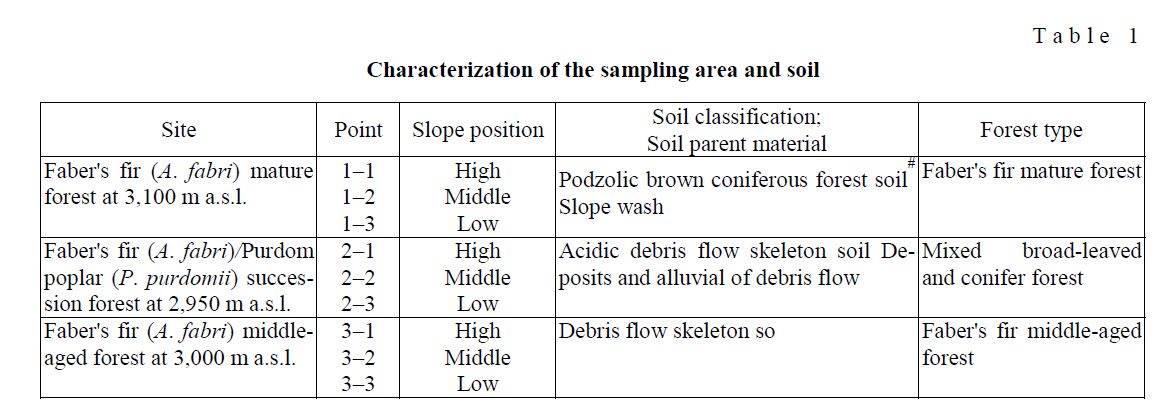
The S-shape distribution of the soil core sampling points was adopted. The soil cores were taken using a core sampler (type XDB 0302, Soil Equipment Limited Company, New Earth Work, Beijing). The length of each core was 100 cm. Each core was sectioned at 0–10, 10–20, 20–40, 40–60 and 60–100 cm depth. Each layer of soil core sample was mixed evenly. Any visible roots and gravels and other impurities were removed. By quartering method, 1 kg of soil sample was packed in polyethylene bags and transported to the laboratory. In total, 9 soil profiles were collected and 45 soil core samples were prepared.
Soil samples were air dried under clean conditions, ground in agate mortar and impurities (small stones, plant debrisetc.) were removed when sieving in laboratory using a plastic sieve of 20 mesh followed by 100 mesh. Dried and sieved soil samples were packed in polyethylene bags and stored in capped polyethylene bottles.
Heavy metal determination. To determine Cd content, each soil sample was hot digested using a mixture of hydrochloric (HCl), nitric (HNO3), hydrofluoric (HF) and perchloric acids (HClO4); Cd was quantified using graphite furnace atomic absorption spectroscopy (GB/T 17141–1997, 1997). To determine Hg and As content, each soil sample was hot digested in aqua regia (1+1) and was quantified by Atomic Fluorescence Spectrometry (AFS). To determine Pb, Cr and Ni content, each soil sample was hot digested using a mixture of HCl, HNO3, HF and HClO4 acids and were quantified with the aid of Inductively-Coupled Plasma Atomic Emission Spectroscopy (ICP-AES) according to the Chinese standard method (Ou et al., 2007). All acids used were of analytical grade (Merck). Analytical quality control and quality assurance were achieved by the analyses of fortified samples and a blank sample with each set of samples.
Soil quality assessment. In order to assess the degree of soil pollution with heavy metals, single-factor and multiple-factor indices approaches were used (Ding, 2001). The use of single-factor approach is related to the degree of soil pollution by a particular compound from which the single soil quality criterion will be obtained. The single factor index method is the basis for multiple factor method. The single-factor index assessment is one of the most popular methods of soil quality assessment widely adopted in China (Ding, 2001; Xia, 1996) [3]. The calculation of the single factor index method can be expressed as:
Pi = Ci/Si, (1)
where, Pi(dimensionless) = The environmental quality index for pollutant «i»; Ci(mg/kg) = The actual measured value for pollutant «i»; Si(mg/kg) = The assessment standard of pollutan.
According to the National Environmental Quality Standards of China adopted by the National Department of Environmental Protection, Mt. Gongga region is a nature reserve. Hence, the soils in the region fall under the standard «Category I and grade-1» which should be used in «Environmental Quality Standard of Soil» (GB 15618–1995, 1995). The comprehensive multiple factor index method is one of the principal methods used for recognizing integrated environmental quality status. The Nemerow’s integrated approach for soil quality assessment is the most popular method adopted to calculate pollution index in China and also in other countries (Gong et al., 2008) [4]. It takes into account both the average value and maximum value of a single-factor pollutant index and emphasizes the influence of relatively important agent on the environmental quality (Xia, 1996). This index is calculated by using formula (2):
PN = {0.5[(Ci/Si) max2 +(Ci/Si)av 2]}0.5 (2)
where, PN = Multi-factor index; (Ci/Si)max = The maximum value of the pollution index of pollutant in soil; (Ci/Si)av = The average value of pollution index of pollutant in soil.
Assessment criterion of soil pollution indices used in China for a single-factor and the Nemerow’s integrated approach by a multiple-factor index is given in Table 2.
Assessment criterion of soil pollution indices (HJ/T 166–2004, 2004)
T a b l e 2

Results and discussion
Concentrations of six heavy metals: The heavy metal concentrations in soil samples were done through statistical analyses with Microsoft Excel and SPSS 17.0 software and the descriptive statistics of heavy metal concentrations in the studied area are summarized in Table 3. Comparing the results with standards range (GB 15618–1995, 1995), showed that the concentrations of Pb, Hg and As in this area are lower than standard (Pb<35 mg/kg,Hg<0.15 mg/k,As<15 mg/kg). However concentrations of Cd, Cr, Ni in our study are higher than standard range (Cd>0.2 mg/kg,Cr>35 mg/kg,Ni>40 mg/kg). Soil of the eastern slope of Mt. Gongga was enriched with Cr (103.4 mg/kg dw) when compared to soil from Mt. Fenghuang Park near the city of Chengdu in Sichuan with a concentration of 82 mg/kg dw (Jia et al., 2009). However, soils from Mt. Fenghuang Park were more contaminated with Cd at 0.45, Pb at 45, Hg at 0.89 and As at 14 mg/kg dw, but Ni level was similar at 40 mg/kg dw (Jia et al., 2009). The Coefficient of Variation (C.V.) values of six heavy metals in the study ranged from 0.24 to 0.91 indicating that they had moderate variations. The C.V. of Cd was 0.91, which was the highest of the 6 heavy metals, suggesting that Cd has the highest variation among the soil samples. The lowest C.V. was for Pb with a value of 0.24, suggesting that Pb has the least variation. The order of the coefficient of variation for the six heavy metals was Cd>Hg>As>Ni>Cr>Pb [5].
Descriptive statistics parameters of heavy metal concentrations in topsoil
T a b l e 3

Comparison of heavy metal concentrations of the three sites. The arithmetic mean concentrations of six major heavy metals in top soil layer from the three sites along the eastern slope of Mt. Gongga were: Cd 0.62±0.51 mg/kg, Pb 40.20±3.23 mg/kg, Cr 85.57±15.18 mg/kg, Ni 23.27±9.32 mg/kg, Hg 0.14±0.01 mg/kg, As 7.02±0.85 mg/kg for the Faber's Fir mature forest site; Cd 0.27±0.03 mg/kg, Pb 23.97±1.03 mg/kg, Cr 143.17±11.74 mg/kg, Ni 60.77±3.05 mg/kg, Hg 0.04±0.01 mg/kg, As 2.14±0.02 mg/kg for the Faber's Fir/Purdom Poplar succession forest site; and Cd 0.24±0.02 mg/kg, Pb 26.97±0.38 mg/kg, Cr 81.47±11.79 mg/kg, Ni 42.77±4.15 mg/kg, Hg 0.03±0.00 mg/kg, As 2.34±0.07 mg/kg for the Faber’s Fir middle-aged forest site.
In the three different forest types, mean concentrations of Cd, Pb, Hg and As in surface layer of the Faber’s fir mature forest were higher than the Faber's Fir/Purdom Poplar succession forest and the Faber's Fir middle-aged forest and it was found that there were significant differences in Pb, Hg and As, but not in Cd (p<0.05; Student t-test; Fig. 2). Meanwhile the mean concentrations of Cr and Ni in surface layer of the Faber's Fir/Purdom Poplar succession forest were significantly higher than the other two (Fig. 2). This phenomenon may be due to different soil parent bedrock geochemical composition and the processes of soil formation and so on Yin and Chen (2000) and Fu et al. (1992). Usually, soils having more clay minerals and organic matters can enrich higher heavy metals, they have apparent characteristic of combined with metallic elements (Chen et al., 2011). In forest ecosystem, heavy metals in soil can be transported as a result of erosion and leaching (Zeng and Zhang, 2001). For aged forests, the amount of heavy metals lost due to soil erosion is much lower but leaching plays a more decisive role. Leaching is closely related to the soil acidity and complexation of organic matters like humic acids, while heavy metal mobility in soil horizon is mainly elevated from highland to lowland (Zeng and Zhang, 2001). This could have resulted in the enrichment of heavy metals in the soils of Faber’s fir mature forest site which in is in a low lying areas [6].
Concentration values of a particular metallic element in soils varied highly between layers of cores and between the cores. For the Faber's Fir mature forest site, at low slope section at 3,100 m soil contained Cd at
1.33 mg/kg dw and in this site’s high slope section Cd was at 0.17 mg/kg dw., which were the highest and lowest content, a difference of nearly 7 times. But for two other gentle-sloping sites of the Faber's Fir/Purdom Poplar succession forest at elevation 2,950 m and of the Faber's Fir middle-aged forest at 3,000 m, the elemental concentrations did not vary obviously with the slope/altitude.
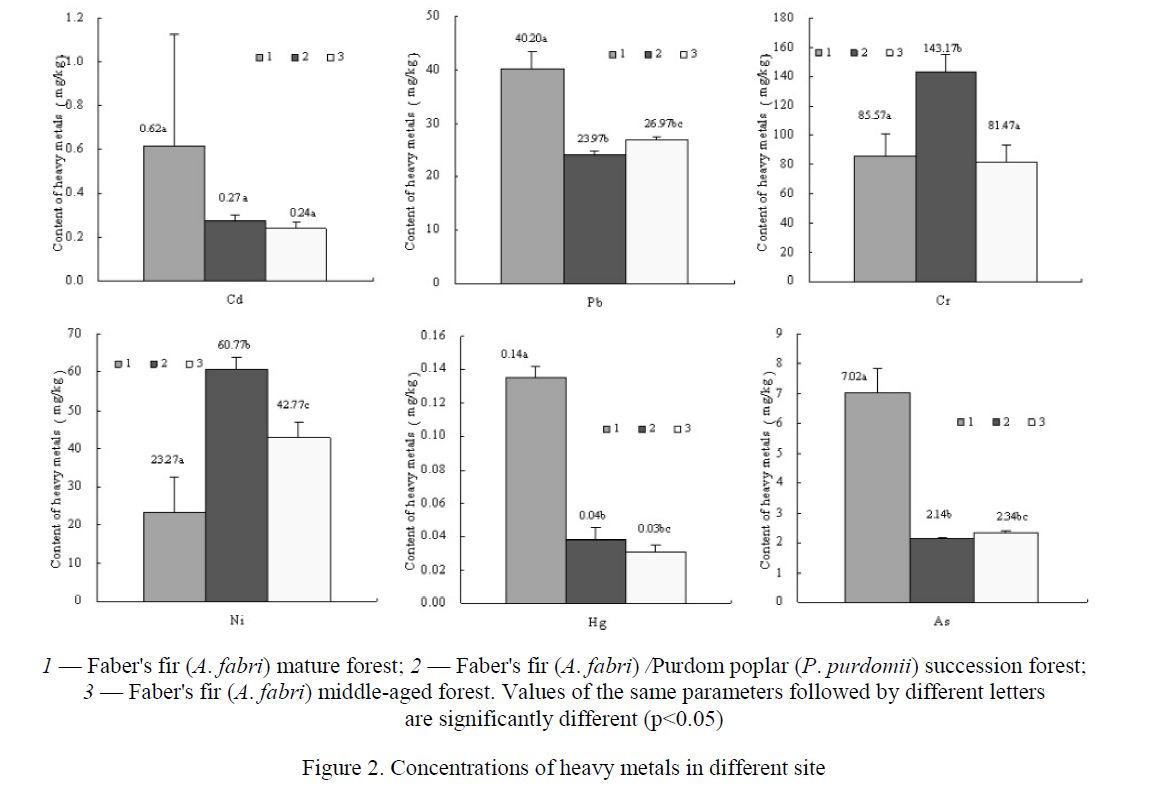
Figure 2. Concentrations of heavy metals in different site
The coefficient of variation values of such heavy metal in the Faber's Fir mature forest site ranged from to 0.83, much higher than that of the other two sites (0.01–0.19 and 0.01–0.14). This is due to steep topography of the Faber’s Fir mature forest, because topography and landforms are the most important factors affecting the spatial variation of soil which in complex topography
Heavy metals distribution in soil profiles. Element distribution in soil can be affected by several factors (Du et al., 2007). Soil of the Faber's Fir mature forest site was characterized by high Pb accumulation in the upper horizon at 0–10 cm (topsoil), while for As, Cd, Cr and Ni there were no significant differences in the different soil layers and Hg in particular is largely enriched in the 10–20 cm layer (Fig. 3). For the Faber's Fir/Purdom Poplar succession forest soil, Cr was mainly concentrated in 10–20 cm layer similar to that of the Faber's Fir mature forest site while As, Ni, Pb were evenly distributed from top to 100 cm depth and Hg accumulated in topsoil (Fig. 3). For the Faber's Fir middle-aged forest soil, concentration of Cd was lowest in the 10–20 cm layer; Ni was lowest in 0–10 cm layer, while Hg is largely enriched in 10–20 cm layer, which is similar to that of the Faber's Fir mature forest site. As, Cr, Pb were no significant differences in different soil layer (Fig. 3).
The distributions of heavy metals in soil layers at each of the three sites surveyed were diverse due to several factors. This observation was not consistent with the phenomenon that all the heavy metals accumulate in the upper layer because certain heavy metals in soil are less soluble in water and therefore less mobile. The results of this study are consistent with the results of a survey performed by Ren et al. (2009). Each type of soil has its unique characteristics resulting from the process of the soil formation. This process releases minerals at different levels of vertical movement, especially in soils of forest zones, where the process of soil formation is largely affected by climate, parent rock’s geochemistry, topography, biology and time and thus the spatial heterogeneity is more evident. Nevertheless, some anthropogenic processes relating to remote sources of heavy metals released by atmospheric transport can also with varying degree, contribute to surface soil heavy metal enrichment.
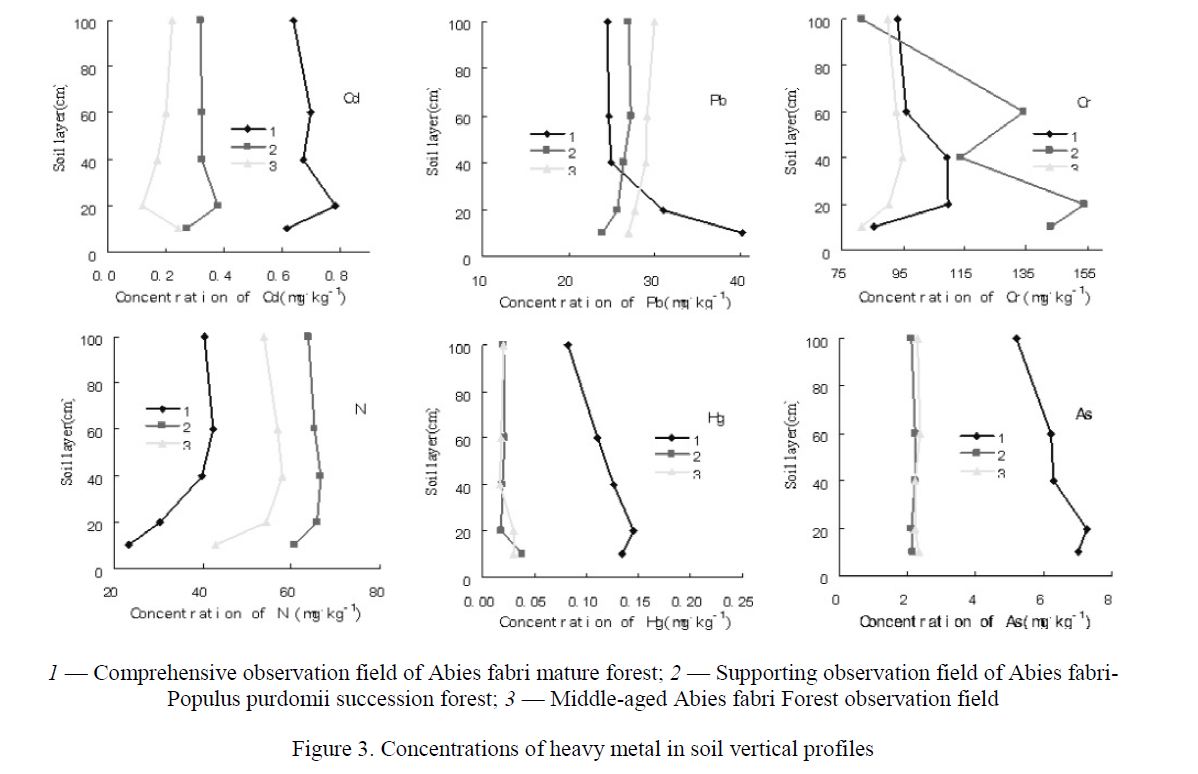
Figure 3. Concentrations of heavy metal in soil vertical profiles
Elemental Hg easily vaporizes and natural thermal (volcanic activity, forest fires) and anthropogenic processes (fossil fuels combustion, waste incineration) contribute to ambient air pollution with mercury. Hg is therefore transportable by global atmospheric diffusion (Fitzgerald et al., 1998) (Table 4). Mercury in its elemental form has a long-life in air. Deposition by aerial fallout can enrich the uppermost layer of soils especially humus abundant forest soils (Falandysz et al., 1996, 2003).
T a b l e 4
Assessment results of soil quality at the east slope of Gongga Mountain by single factor contaminant index (Pi)
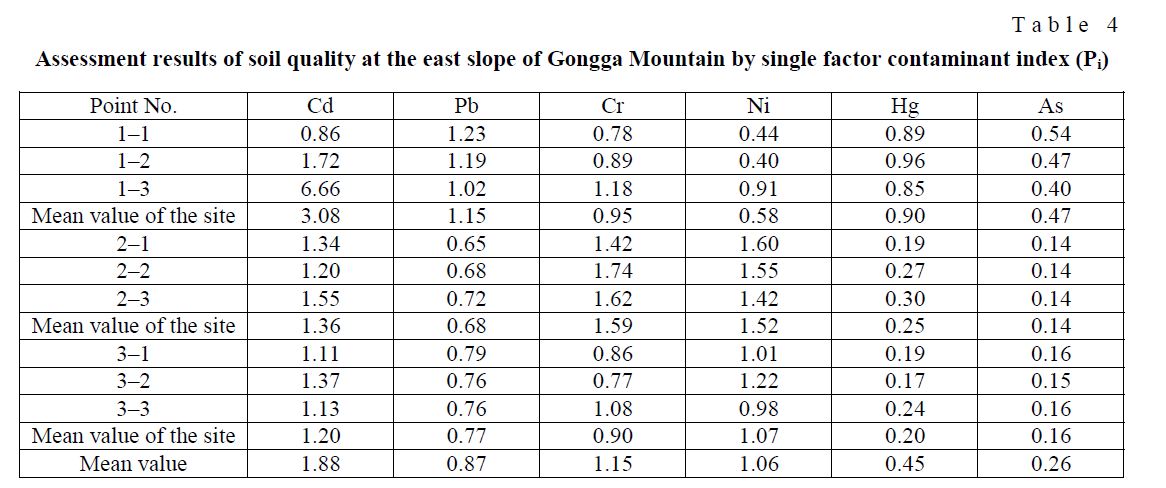
Anthropogenic thermal processes (combustion, incineration) also contribute to release and subsequent deposition of Pb and Cd. Nevertheless, atmospheric residence time and therefore long-range transport of atmospheric particles rich in Pb and Cd is lower than Hg (Sturges and Harrison, 1986; Tasić et al., 2006).
Soil quality, Single-factor pollutant index assessment. The single-factor contaminant index (Table 4) was calculated by taking into account the analytical data obtained from topsoil at each sampling site. Among the heavy metals examined, the highest degree of pollution along the eastern slope of Mt. Gongga was for Cd (Table 4). For this element, 89 % of top soils analyzed were considered polluted and the mean value of Pi pollution index for Cd was 1.88. Hence, soils in that region can be assigned a pollution index category of 1<Pi≤2, as can bedescribed as «slightly polluted» with Cd. An exception was the sampling point no. 1–3, where Pi index value for Cd reached 6.66 (Table 4). This location is classified as ‘very severely polluted’ (Pi>6) category. In case of Cr, 56 % of the sites were slightly polluted (1<Pi≤2) with a mean value of pollution index of 1.15. In the Wutai Mountain soils, a positive correlation between Cr and organic matter content was found but a negative correlation between Cr and soil pH or soil sand content (Fan and Chen, 1999). The high concentration of Cr in soils of the studied area may be related to the high percentage of forest cover, biological activity, acidic pH and high organic matter content. Moreover, rainfalls in the area and high leaching contribute to Cr enrichment. The proportion of soils with the category of ‘slightly polluted’ (1<Pi≤2) with Ni was 56 % and mean value of pollution index was 1.06 (Table 4). For Pb, mean value of a singlefactor pollution index was 0.87. Nevertheless, 33 % of topsoil in the area and all of the Faber's Fir mature forest area can be characterized as ‘slightly polluted’ (1<Pi≤2) with Pb (Table 5). An explanation for enrichment of Pb in surface layer of soil at this site can be its proximity to the nearby parking lots. Pb contained in leaded gasoline exhaust of vehicles and in atmospheric particles (mainly as sulfates and halides), accumulate at the surface-largely as PbS and to a lesser extent as PbCO3, PbSO4, PbCrO4 and Pb-organic chelates (Panayotowa, 2000; Xu and Liao, 2004). This deposition was both firmly confined to surface soil because of lead’s immobile nature in soil horizon.
Assessment results of soil quality at the east slope of Gongga Mountain by multi-factor contaminant index (PN)
T a b l e 5
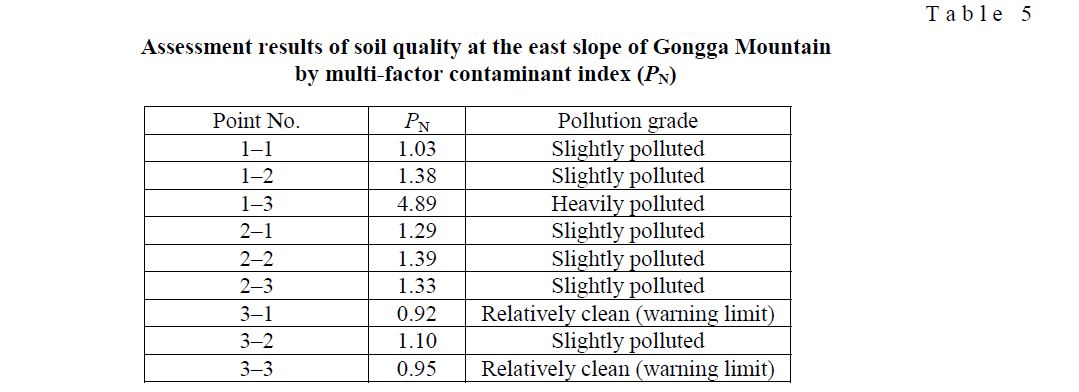
The single-factor pollutant index values for heavy metals in topsoil decreased in the following order as PCd>PCr>PNi>PPb>PHg>PAs. Evidently, topsoil of the eastern slope of Mt. Gongga accumulated Cd and Cr and less amount of Ni. In light of these results, soil contamination with Cd was the most serious issue along the eastern slope of Mt. Gongga, followed by Cr. Soil at each sampling site suffered from Cd contamination. Enrichment was most evident in the Faber's Firmature forests, which may be attributed to acidity of the coniferous forest soil and its location in wet climatic regions. The adequate supply of rainfall and thriving vegetation were favorable to accumulation of organic matter in the soil, which further supported Cd enrichment.
Multi-factor pollutant index assessment. An integrated assessment of topsoil quality for six heavy metals assessed will provide a more comprehensive picture than a single-factor approach. Since the values of index PN for all sites varied between 0.92 and 4.89, all these values should be considered as slight to pronounced impact with heavy metals (Table 5).
For 22 % of the topsoil’s, the multi-factor pollution index was 0.7<PN<1 which implied lack of pollution but warning of a problem. For 67 % of the topsoil analyzed, the integrated index was 1<PN<2, which suggested ‘slightly polluted’ nature of soils (Table 5). Topsoil at Faber's mature forest site showed a PN index value of 4.89 which indicates heavy pollution. This particular site has already attained the level of ‘serious’ pollution. The minimum PN index value was observedat the Faber's Fir middle-aged forest area. At this area a relatively clean to slightly polluted soils were found and this site needs further attention too. As discussed above, increasing traffic in the region due to increasing tourist attractiveness of Mt. Gongga and the booming tourism and some manufacturing activities contributed to soil environment contamination with heavy metals.
Nevertheless, this region was also affected by natural factors such as the parent rock geochemistry, climate and soil erosion.
Conclusion
Mt. Gongga region is among the areas of the world with unique nature and biodiversity and is relatively remote to industrial and urban areas. The results of this study implied that heavy metal content of soils along the eastern slope of Mt. Gongga may be affected by natural factors such as the parent rock geochemistry, climate and soil erosion but also by anthropogenic factors such as traffic, which resulted in the accumulation of heavy metals in the environment.
References
- Bermea O.M., Hernández-Álvarez E., González-Hernández G., Romero F., Lozanoet R. et al. Assessment of heavy metal pollution in urban topsoils from metropolitan area of Mexico City // Geochem. Explor. — 2009. — Vol. 101. — P. 218–224.
- Chen F.B., Gao S.H. Research on Alpine Ecosystem in Gongga Mountain. — Chengdu University of Science and Technology Press. — China,
- Chen , Zhang H., Zeng X., Liu J. Spatial variation and environmental indications of soil arsenic in Guangdong province // Ecol. Environ. Sci. — 2011. — Vol. 20, No. 5. — P. 956–961.
- Ding S.L. Introduction to Environmental Assessment. — Chemical Industry Press. — China,
- Moreno-Jiménez E., Peñalosa J.M., Manzano R., Carpena-Ruiz R.O., Gamarraet R. et al. Heavy metals distribution in soils surrounding an abandoned mine in NW Madrid (Spain) and their transference to wild flora // Hazard. Mater., 2009. — Vol. 162. — P. 854–859.
- Wei, G., Yang L.S. A review of heavy metal contaminations in urban soils, urban road dusts and agricultural soils from China // Microchem. J. — 2010. Vol. 94 .— P. 99–107.